| Welcome! to the ima Emailer ~ December 2008 Issue |

The IMA EMAILER brings you news from ima pros Fred Roumbanis, Michael Murphy, Bill Smith and ima pro staffers across the USA and worldwide.
| ima’s Year in Review and Going Forward |
Welcome to our year-end review where ima pros Michael Murphy and Captain Karl Bunch reflect upon where ima is now, and where ima’s headed product-wise.
In terms of products, ima has designed, tested and released five bass lures in the USA within approximately the past 18 months.
Although ima’s a company from Japan, these bass lures are made for North American bass anglers, and are not sold in Japan:
- Roumba wakebait
- Flit 120 jerkbait
- Shaker flat-sided shallow-running crankbait
- Skimmer topwater
- Rock ‘N Vibe lipless crank
For 2009, four new ima bass lures are under development:
- Rattlin’ Roumba for spring time release
- Big Stik topwater for summer release
- Baby Flit 100 for autumn release
- Shaker shallow crankbait (release date not yet decided)
With less than two years in the North American bass market, ima’s still in its infancy. It will take a little longer for ima to grow, that’s only normal, to get to the size that ima will eventually be. But there’s no doubt that ima’s off to a good start, and they’re here to stay. So check them out. They’re great baits. True, you may spend a little bit extra on ima, but you’re going to get what you pay for from ima. A good lure is the most vital piece of equipment that stands in between you and the fish you desire. You can buy any ima baits, and you’ll be able to rely on them with confidence.
That’s ima’s commitment to you for now, and for the new year. Thank you.
| ima Roumba |
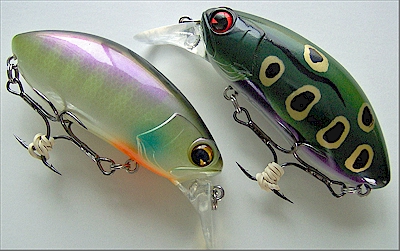
Where we are now – ima Roumba Wakebait / Shallow Crankbait
- Michael Murphy: Places where the Roumba’s most advantageous are where you see a lot of shallow grass and overall, the Roumba’s really good when fish are shallow. There have been times I’ve caught fish with the Roumba by waking it in over 50 feet of water, but I think where the Roumba really shines is anytime when you’re anywhere shallow, and especially during the spawning season. That’s not to say the Roumba won’t work in the summer or fall – it does. But around the spawn when the fish are wanting to be in the shallows for a month or two, that’s when the Roumba really plays a role.
The Roumba’s a good search tool when there are a lot of average size fish, say your 2-3 pounders. They may not always take the bait solidly but they will come up behind the Roumba and show themselves. So it’s a search tool, and it will tell you where a few of those 2-3 pound fish are, and they’ll go right back to a piece of cover, a log, or a stick-up. Some fish may have a bed that the Roumba pulled them away from… and they’ll go back into those spots. So you can pick up something else, a Texas-rigged worm or a Senko, and catch those relatively smaller fish that wouldn’t commit to the Roumba.
That’s not to say you will not catch these 2-3 pounders on the Roumba. Yes, you will get a fair percentage of them – but not all of them will strike.
What you’ll find different when it comes to bigger bass, is that you will pretty much stick the huge fish that come up on the Roumba. Usually, if you get around a big fish, it will commit. So the Roumba, if you throw it enough, it will definitely increase your chances to get those bigger fish, and in a tournament situation, the Roumba will get those good kicker fish you need these days. The Roumba has been proven to get that better grade of fish in shallow cover.
- Captain Karl Bunch: The Roumba is designed primarily to be a topwater wakebait. Simply hold the rod tip at about ten or eleven o’clock and just a steady retrieve on a medium/heavy rod will give it a nice, wide wobbling wake. There’s no rattle, just a wake – and that’s what gets their attention.
The neat thing about the Roumba, if you are searching a shoreline, trying to find fish, you can effectively and easily cover a shoreline by first making three casts with the rod tip up to use the Roumba as a surface-roiling wakebait. Then make the next three casts with the rod tip down, so it runs about a foot deep with a real wide wobble. Depending on the fishing line used and retrieve speed, with the rod tip held down, the Roumba gets anywhere from 12-18 inches deep, typically about a foot. The effectiveness of this is that there are times when bass just don’t want to come up and hit a topwater. There are times they’re down tight on the wood, in the shallow wood, and using the Roumba as a shallow crankbait, it will come through wood cover very well. It will also come through light or scattered vegetation very well. The beauty is you don’t have to constantly switch between one rod for topwater and another rod for shallow-cranking. You can just use one rod, and the Roumba saves you a lot of time, saves a lot of energy and let’s you effectively and quickly cover a shoreline using it as a search bait.
When I am guiding clients, I’ve had many days when the weather conditions may have changed overnight, when we must hunt to find the fish, and I’ll just instruct my clients to do the same thing – make three casts using the Roumba as a topwater wakebait and three casts with the rod tip down, using it as a shallow running crankbait. Used this way, the Roumba has found the fish for me and my clients quickly and effectively many, many times, resulting in successful, productive trips.
| ima Rattlin’ Roumba |
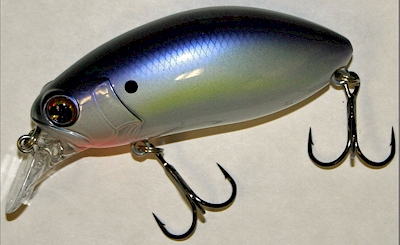
Where we’re headed – ima Rattlin’ Roumba. Spring 2009 Release.
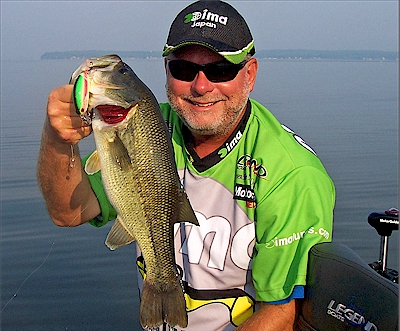
Captain Karl Bunch shows a bold new color named ‘Double Cheeseburger’ for stained or muddy water.
- Captain Karl Bunch: The Rattlin’ Roumba will be available in the spring time, and it’s going to expand the Roumba’s effectiveness. A guy who fishes water that’s really stained or muddy and feels he needs the rattling noise to go along with the wake, the Rattlin’ Roumba will allow him to do that, and it’s going to come in a few new, brighter colors to give dirty water anglers even more confidence. So the Rattlin’ Roumba will have some brighter colors for dirty water, in conjunction with the rattling noise.
- Michael Murphy: The addition of the Rattlin’ Roumba is really going to help in those painful tournament situations when you may have fish located shallow, maybe even sight-fishing on beds, but then the water dingies up overnight, whether it be from rain, wind or whatever causes a dirtier water situation overnight. So you still know the fish are there, you just can’t see them or you need to alert them a little bit more to the lure’s presence. The regular Roumba may not be enough in dingy water. That’s where the Rattlin’ Roumba can definitely help you. The wake is still there, with the rattling noise to help them locate it better in dingier water.
So you’ll have two options. The Rattlin’ Roumba will be good in dirty water, but that same rattling noise may be too much for clear water where you may do better with the original non-rattling model.
| ima Skimmer |
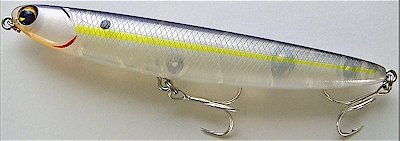
Where we are now – ima Skimmer Topwater
- Michael Murphy: In comparison to the Roumba (which is ideal for heavy cover, shallow backwater areas), I consider the Skimmer as more of an open water baitfish type of topwater bait. I’m not saying the Skimmer won’t work in a backwater spot (and vice versa), but the Roumba is more apropos for a shallow, spawning situation or vegetation. The Skimmer and Roumba also move different, and the actions are different. The Roumba is more like a bluegill or frog type lure for shallow cover situation whereas the Skimmer is more of a shad or pelagic baitfish lure for open water. So I tend to use the Skimmer more on main lake points, over deeper water, around rocky, sandy or clay shorelines without much vegetation or cover. With the Roumba, you would probe and pry and dissect shallow cover whereas the Skimmer is more for open water, schooling bass, and suspended bass situations.
- Captain Karl Bunch: The Skimmer one of the easiest small pencil type stickbaits you’ll ever throw. It doesn’t require a lot of technique, and it’s surprisingly effective on brackish water striped bass that share tidal water with largemouth and smallmouth as well.
In fact, the Skimmer is gaining a strong following among ocean surfcasters use to the Skimmer’s solid construction and because of the long distance casts that can be achieved (for its size).
| ima Big Stik |

Where we’re headed – ima Big Stik. Summer 2009 Release.
The Big Stik is a through-wired hard plastic bait, and right now there are only limited prototypes available of the Big Stik.
It’s going to be big on the West Coast for California’s trophy largemouth, and also in Texas and Mexico. It will be very effective for striped bass, either in freshwater or salt.
Since it’s through-wired, a continuous length of heavy wire runs from the nose to tail, including the belly hanger. So it will be able to stand up to all your inshore saltwater battlers, big striped bass, bluefish, peacock bass, pike and musky too.
| ima Rock ‘N Vibe |
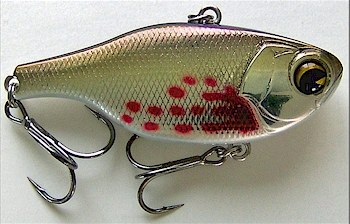
Where we are now – ima Rock ‘N Vibe Lipless Sinking Vibration Bait
- Captain Karl Bunch: As a fishing guide, the Rock ‘N Vibe has become one of my best friends. This lipless crankbait works like a charm. It has good action at any retrieve speed. So anglers can’t fish it wrong. Anyone can use it very slow, medium speed or fast, and the Rock ‘N Vibe doesn’t lose its action. So when I have a guide trip, and fish are hitting the Rock ‘N Vibe, I know my clients are going to have a good day no matter how they use it!
One of the things that is also amazing to me is that the Rock N Vibe can be fish it as a deep water, vertical jig or ‘blade bait’. This can be very effective around bridge pilings and stuff. Some of these places can be snaggy and filled with all kinds of man-made cover where you may get hung up a lot. So I’ll just throw some of my older, beat up and less expensive blade baits until I get to know the terrain and the cover in the area, and then I’ll throw the Rock ‘N Vibe in there tight around the bridge pilings and stuff, and it’s very effective.
- Michael Murphy: The Rock ‘N Vibe lipless crankbait shines best when water is around 45-55 degrees. That ten degree spectrum is going to be in spring and fall, and it’s when you have a lot of baitfish movement. That’s the water temperature range when fish may be transitioning off a jerkbait bite (in spring) and when they are coming off a jerkbait bite, that’s a pretty good time to show them the Rock ‘N Vibe. This is the time when fish are going to get active in newly-growing grass, also starting to move up onto warming flats, and the Rock ‘N Vibe takes center stage at that time.
Off deeper ledges or channel breaks in the summer, the Rock ‘N Vibe may also be used like a hard plastic jigging spoon – one that rattles – in the summer. But where it’s really going to shine is in spring and fall, when it’s just a little too warm for a good jerkbait bite, that’s Rock ‘N Vibe time.
| ima Flit 120 and Baby Flit 100 |
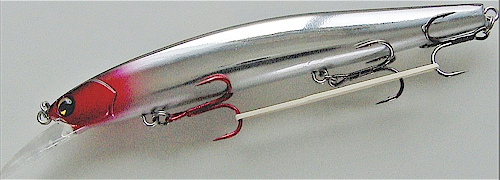
Where we are now – ima Flit 120 Jerkbait
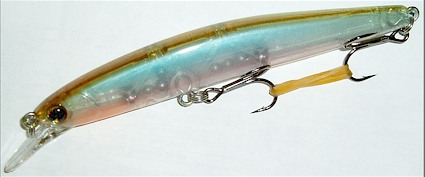
Where we’re headed – ima Baby Flit. Autumn 2009 Release.
The Baby Flit will be 100mm long.
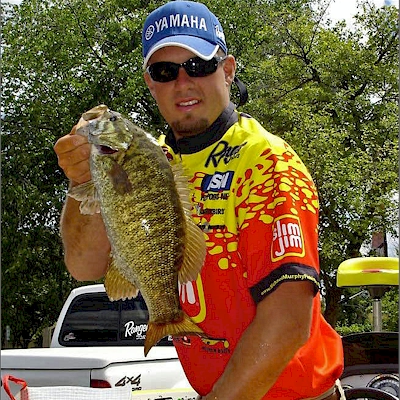
Ima pro Michael Murphy is designer of the Flit jerkbait.
- Michael Murphy: The Flit 120 is a bait that you can fish almost year round. Of course, when you get way up north, smallmouth country, there is not going to be any bad time to throw a Flit. If smallmouth are around, they will always eat a Flit.
When you get into more southern areas, the Flit’s most effective in cooler spring, winter and fall months. But even in the summer, when the water’s warm, I’ve had some killer days when the wind comes up.
In summer, a lot of main lake fish usually stay either very deep or very shallow, and since the Flit 120’s working depth is about 6-8 feet deep, it’s not good for very shallow or very deep fish. It is going to hang up in shallow grass and scum – or it isn’t going to reach them when they sulk on the bottom in deeper water on windless summer days. But you can have some killer days with main lake fish on windy days. All the fish will all start schooling off wind-blown points and on top of any other underwater rises. These fish will tend to suspend up high in the water column. They’ll suspend no more than 10-12 foot deep off points, humps and any other bottom uprisings that are facing into the wind, with wind-generated current moving past. When the wind dies down, these fish will move back up too shallow or descend too deep for the Flit 120 to be effective. But while the wind blows, the fishing can be phenomenal with the Flit 120 for suspended fish on wind blown structure in summer.
My most consistent and productive time of year, however, for the Flit 120 seems like its when the water is always at its cleanest and clearest in the early spring, before the spring rains come. At times when there are no algae blooms, not so much rain, that’s when the jerkbait bite can be best.
Switching the conversation to the new Baby Flit 100 which will be released in 2009, I’ve found that when it is super cold water, fish don’t want a bigger profile jerkbait at that time. So the Baby Flit can be more effective in super cold water.
And in those shallow, backwater areas, where the regular Flit 120 goes a little too deep and hangs up, I’ve found that the Baby Flit will stay just above the grass line, even a very grassy lake like Guntersville, Alabama.
The Baby Flit doesn’t go near as deep. Whereas the Flit 120 goes 6 to 8 feet deep, the Baby Flit goes 4 to 6. So it can stay right above that depth of grass; you won’t be hanging up as much, and it is a friendlier, smaller size of jerkbait that’s more acceptable at times when fish won’t commit to a bigger bait.
The Baby Flit has one less hook, but they’re the same size hooks as on the Flit 120. Also, there isn’t a major weight difference, castability difference or any difference in the tackle you would use with either the Flit 120 or the Baby Flit. You can throw both of them on the exact same rod, same line and same set-up. You won’t have any problems to switch from the bigger Flit to the smaller one. As small as the Baby Flit is, it casts like a bullet. and since it has the same size and strength hooks as the Flit 120, you don’t need to treat it any differently, except it fishes a shallower depth and has a smaller baitfish profile. The only downside is, it seems so long to wait until autumn 2009 to get your hands on it!
| ima Shaker and Shad |
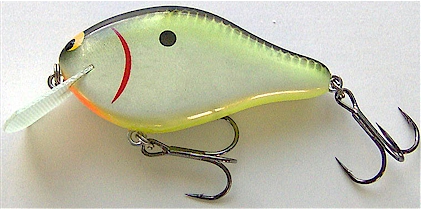
Where we are now – ima Shaker Flat-sided Crankbait in Captain Karl’s favorite color, Plemmons.
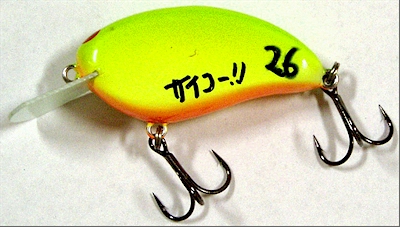
Where we’re headed – a prototype of the ima Shad. Release Date Not Yet Decided
You can consider the ima Shad to be pudgy but not fat. The top and bottom is rounded but it does have somewhat flattened sides. So it isn’t completely round. The biggest difference is the Shad’s going to be more of (but not entirely) a rounded body crankbait whereas the Shaker is a flat-sided crankbait. The Shad’s not going to run any deeper. Both are shallow-runners, although the Shad’s a slightly smaller bait than the Shaker.
- Captain Karl Bunch: I use the Shaker a lot. Earlier I had talked using the Roumba as a shallow-running crankbait which gets about a foot deep. Some days you will find that’s not deep enough to get bites. So when there’s a need to go deeper, the Shaker is the bait I tie on.
The Shaker runs 4-6 feet deep, depending on retrieve speed and line diameter (I like to use 10 lb test with it). It has lots of wobble, and surprisingly, it comes through the edges of grass lines a little bit better than many other cranks. The Shaker has such a wide wobble that it helps keep itself clean of grass and sheds debris. It also comes through wood pretty good, and it floats. So if you feel it hitting a limb, you can stop it, and it will float up so you can snake it over the limb and it won’t hang up.
In terms of water clarity, I have fished the Shaker from clear to stained to muddy water, no problem. As the water gets muddier, I just throw on a brighter color. One of my favorite ‘go to’ colors is Plemmons. The Plemmons color seems to work in just about any water clarity.
- Michael Murphy: Earlier, I talked of using the Flit jerkbait in colder water, and I mentioned my preference for using the Rock ‘N Vibe when the water ranges between 45 to 55 degrees. That’s also close to the water temperature range when I prefer throwing the flat-sided ima Shaker. More precisely, the 50-60 degree range, both in spring and fall when the water’s in the fifties, is when I do best with the flat-sided Shaker. I typically use it when shad or any type of baitfish abound.
Both the Shaker and the prototype ima Shad have computer-board lips. This is a lightweight, ultra thin lip material that creates a lot livelier action than other baits with a thicker, heavy plastic bill on them. In river systems, where there’s a lot of water current, the Shaker and Shad work especially well, since the light, thin lips let them produce superior lure action. Whenever there’s any water current, they mimic baitfish swimming in the current. Even little streams and creeks that you can’t get a boat into, where you wade, the shallow-running Shaker and ima Shad do well because the moving water just activates them. In these moving water situations, you don’t have to do a whole lot to do well with these two baits.
The difference I’d say when it comes to the ima Shad prototype versus the Shaker, the Shad’s more of a rounder version, and that makes it even more of a summer type bait. So when the water is even warmer, say when the water temperature’s 55 to 65 or even up to 75, that rounder shape and the little different action makes the prototype ima Shad even more of a summer bait – especially in rivers or any water current situations.
Well, there you have it! Those are our year-end reviews of the five ima hard baits available to you today, and previews of the four ima baits under development for 2009.
| Thank You! For Reading the ima Emailer |

ima’s a big name in Japan where ima is known for its hardbaits. ima is now making a big name for itself in North American too, with the help of U.S. bass pros who have designed new ima hardbaits for the USA.

